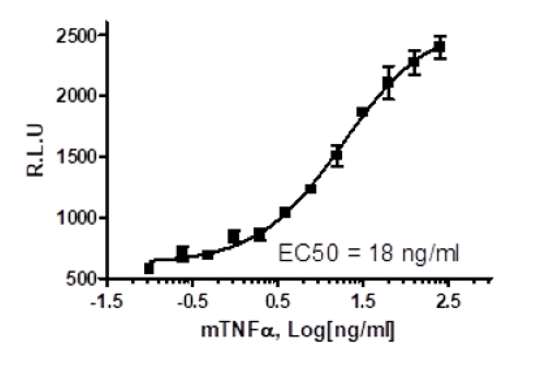NF-κB Luciferase Reporter Raw 264.7 Cell Line
NF-κB Luciferase Reporter Raw 264.7 Cell Line is a Raw 264.7 cell line expressing firefly luciferase driven by four copies of the NF-kB response element located upstream of the minimal TATA promoter. After activation by pro-inflammatory cytokines or stimulants of lymphokine receptors, endogenous NF-κB transcription factors bind to the DNA response elements, inducing transcription of the luciferase reporter gene. This cell line has been functionally validated and responds to TNFα and RANKL
Interested in screening and profiling inhibitors or activators of NF-κB-mediated signaling without the need to purchase and license the cell line? Check out our Cell Signaling Pathway Screening.
Purchase of this cell line is for research purposes only; commercial use requires a separate license. View the full terms and conditions.
Media Required for Cell Culture
| Name | Ordering Information |
| Thaw Medium 11 | BPS Bioscience #79976 |
| Growth Medium 11A | BPS Bioscience #79977 |
Materials Used in the Cellular Assay
| Name | Ordering Information |
| Mouse RANKL | R&D Systems #462-TEC-010 |
| Mouse TNFα | R&D Systems #410-MT |
| ONE-Step™ Luciferase Assay System | BPS Bioscience #60690 |
| White clear-bottom 96-well cell culture plate | |
| Luminometer |
The cell line has been screened to confirm the absence of Mycoplasma species.
The role of NF-κB (nuclear factor-κB) activation is well-characterized in canonical (classical) and noncanonical (alternative) signaling pathways of inflammation. Two major forms of innate immune sensors are Toll-like receptors (TLR) and NOD/CATERPILLAR proteins. Mutations in NOD2 (nucleotide-binding oligomerization domain-containing protein 2) have been linked to chronic autoinflammatory and autoimmune diseases, such as Crohn’s disease and Blaus syndrome. Studying the canonical and noncanonical NF-κB pathways and the influence of TLR pathways and NOD2 mutations can further our understanding of autoimmune regulation. Raw 264.6 is a murine macrophage cell line useful for studies involving immunoreactivity. The use of a luciferase reporter allows for easy read outs in cellular assays.
Peninnger, J. M., et al., 2006 Trends Mol. Med. 12(1):17-25.
Baeuerle, P.A., 1998 Curr Biol. 8(1):R19-R22.



